Ask a question, get an answer ASAP!
GET A QUOTE
Spare Tire Installation Cost
Service Location
Price range for all vehicles
Getting a flat tire can put a damper on your day and your wallet.
Tires can go flat due to many issues including:
The most common cause of a leaking tire is a puncture from a nail or screw.
When a nail punctures a tire, it can either stay embedded in the tread or can enter and come straight out. The tire pressure leaks from the puncture hole and the tire eventually goes flat.
In either case, a puncture can be repaired if it occurs in the tread section of the tire.
Tip: If you have a slow leak in your tire, have it repaired soon after. If you top up the tire pressure without repairing the puncture, rust and corrosion can form in the steel belt layer, causing further damage such as belt separation and steering wobble.
Note: A proper tire repair includes removing the rubber tire from the wheel rim. While kits are available on the market to plug a tire from the outside, it is not an approved repair method and does not meet Department of Transportation (DOT) standards.
A proper tire repair can be done in one of two ways:
Here’s how to perform a tire repair with a combination patch.
Use the following steps to check your tire for any leaks and determine the location of the puncture.
Materials Needed
Step 1: Spray soapy water over the tire with a spray bottle. Focus on areas that are likely to have a leak such as the bead, the valve stem, and the tread section.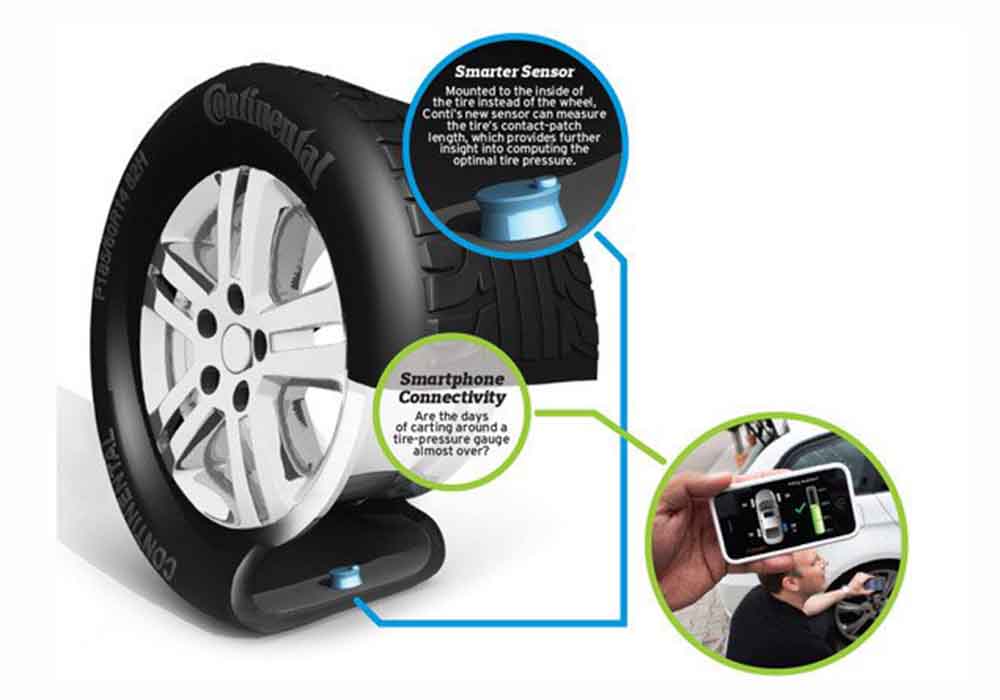
Coat the tire a little at a time with soapy water. You’ll know where the leak is when you see big or small bubbles forming in the soapy water.
Step 2: Locate the leak. Mark the location of the leak with a tire crayon. Mark the location of the valve stem on the sidewall as well so that you can orient the tire properly when you reinstall it.
You will need to remove the tire from the wheel rim in order to be able to fix the puncture.
Materials Needed
Step 1: Deflate the tire completely. If your tire still has air, remove the valve stem cap, then remove the valve stem core with the tool.
 Be careful to control the valve core and hold it so you can reuse it after the tire is repaired.
Be careful to control the valve core and hold it so you can reuse it after the tire is repaired. The tire will take less than a minute to completely deflate with the valve core out.
If your tire is already completely empty of pressure, skip to the next step.
Step 2: Break the bead. The smooth lip of the tire seals tightly to the rim and needs to be separated from the rim.
Lay the tire and rim flat on the ground. Place the bead breaker bar snugly under the lip of the rim on top of the tire and pound on it with a heavy hammer, wearing eye protection and work gloves.
Continue around the whole tire bead in the same fashion, moving along once the bead begins to move. When the bead is fully unseated, it will sink loosely downwards. Flip the wheel over and repeat the process for the other side.
Step 3: Pry the tire off the rim. Place the end of the bar under the lip of the tire and against the rim and pry the tire upwards. A section of the rubber lip will be above the edge of the rim.
A section of the rubber lip will be above the edge of the rim.
Using a second bar, pry around the rest of the bead until it is fully above the edge of the rim. The second lip will come easily off the rim with a bit of wiggling. Use a pry bar to lift it above if it’s not coming off easily.
Apply the patch and plug into the puncture to fix your flat tire.
Materials Needed
Step 1: Evaluate the tire’s condition. If there are black pebbles or dust inside the tire, or if you see cracks or cuts on the inside of the tire, that’s an indication the flat tire was driven for too long. In this case, discard the tire and replace it.
If the inside of the tire is shiny and free from debris, continue with the repair.
Step 2: Ream the puncture hole.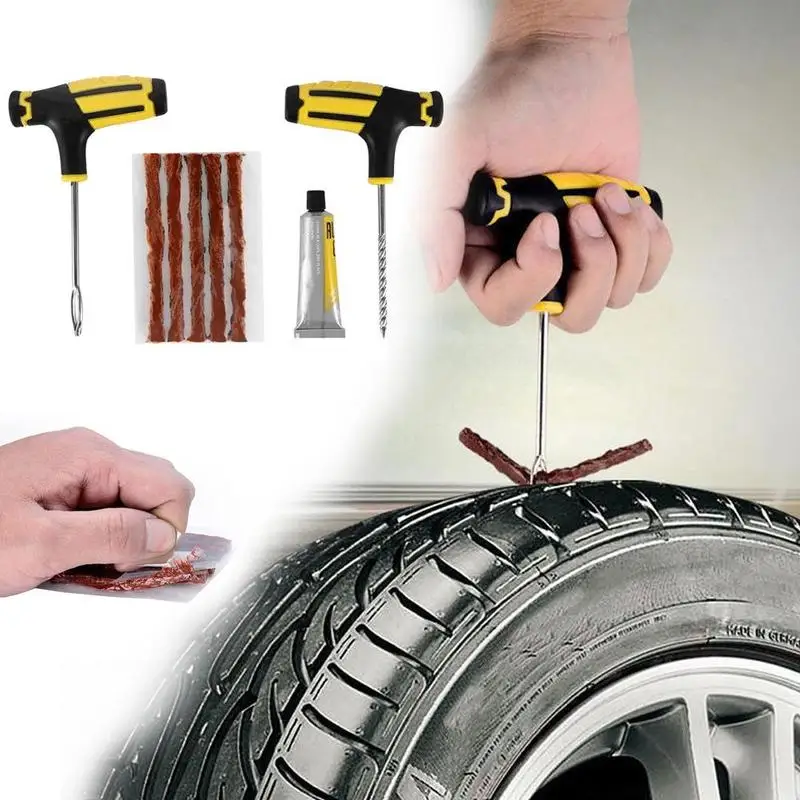 Locate the hole inside the tire opposite the mark you made on the tread. Insert your reamer into the hole from the inner side of the tire, pushing it deeply into the hole and back out at least six times.
Locate the hole inside the tire opposite the mark you made on the tread. Insert your reamer into the hole from the inner side of the tire, pushing it deeply into the hole and back out at least six times.
Step 3: Rough up the inside of the tire at the hole. Use a manual rasp or a piece of diamond-grit sandpaper to rough up a spot just larger than the patch area. Brush away any loose rubber that may have formed.
Step 4: Apply a generous layer of rubber cement. Brush the cement over an area just larger than the patch. Let it set according to the instructions on the container.
Step 5: Push the plug part of the patch into the hole. Pull the protective backing off of the patch, then insert the plug into the hole. There is a stiff wire at the end of the plug. Insert it into the hole, pushing it through as far as you can.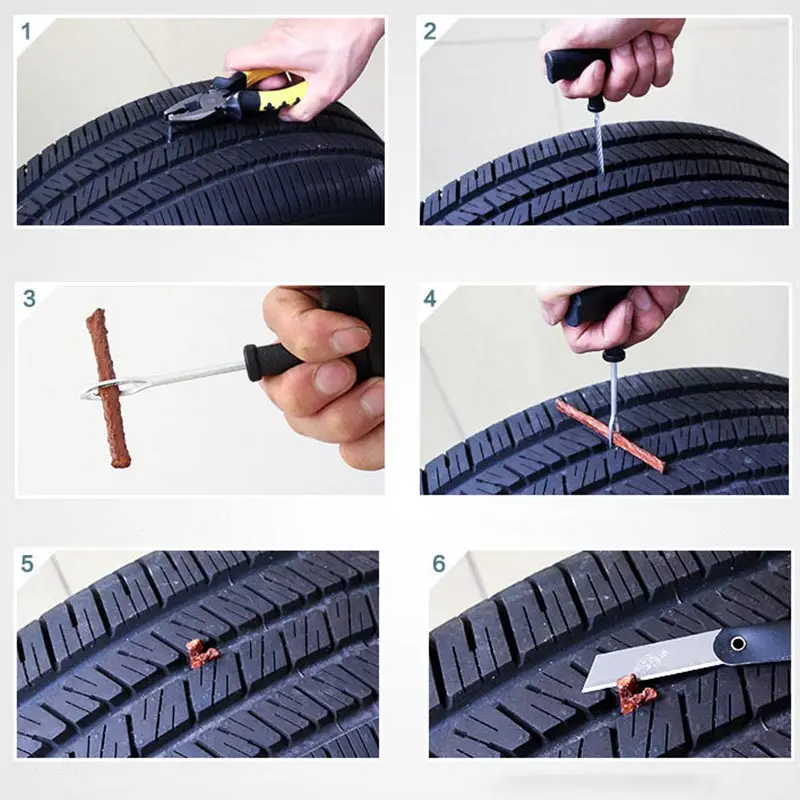
Note: The plug needs to go deep enough that the patch rests fully on the inner tire liner.
Tip: The fit will likely be tight, and you may have to pull the plug the rest of the way with a pair of pliers. Pull on the wire part to fit the plug correctly.
Step 6: Seat the patch with a roller. With the combination patch all the way in place, seat the patch in the rubber cement with a roller.
Step 7: Cut the protruding plug flush with the tire tread. Use a utility knife to cut the plug flush with the tire surface. Don’t pull on the plug when cutting it.
After repairing the puncture, you need to put the tire back on the wheel rim.
Materials Needed
Step 1: Orient the tire in the proper direction.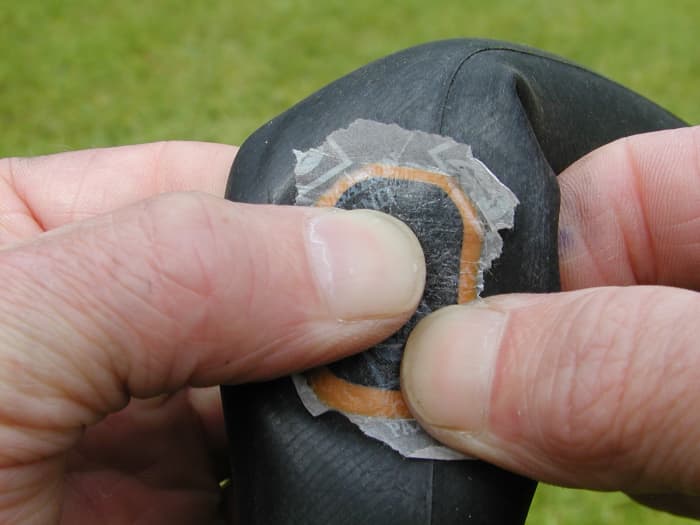 Use the valve stem marking to line it up on the correct side and position in the rim.
Use the valve stem marking to line it up on the correct side and position in the rim.
Step 2: Install the tire back onto the rim. Press the tire over the rim and wiggle it into position. The bottom side should drop easily into place. The top side may take some effort like twisting the tire or putting pressure around the bead.
If necessary, use a bar to pry the rubber back under the rim.
Step 3: Install the valve stem core. Make sure the valve core is snug to prevent leaks.
Step 4: Inflate the tire. Use a compressed air source to put air into the tire. Inflate it to the recommended tire pressure for your vehicle, found on the driver’s door placard.
Step 5: Recheck the tire for leaks. Spray the tire with soapy solution to confirm the leak is repaired and the tire is seated on the bead.
Even though a tire plug might be sufficient by itself, national road safety agencies caution against using only a simple plug.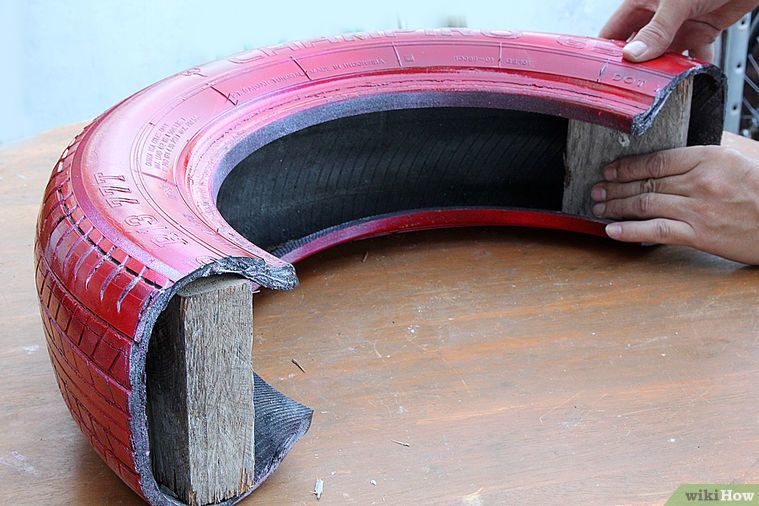
In some situations, relying on a plug might be less effective.When the puncture hole is near the tire’s sidewall, many experts recommend a patch as a simple plug may not be enough to completely seal the damage. When the puncture is diagonal and not straight, a patch will need to be applied. A plug-patch is the ideal solution to such situations involving a flat tire.
If you find that your tire is not inflating properly even after repairing the puncture, get a certified mechanic, such as one from YourMechanic, to inspect the tire and install your spare tire instead.
The most popular service booked by readers of this article is Spare Tire Installation. YourMechanic’s technicians bring the dealership to you by performing this job at your home or office 7-days a week between 7AM-9PM. We currently cover over 2,000 cities and have 100k+ 5-star reviews... LEARN MORE
SEE PRICING & SCHEDULING
Tires
flat tires
The statements expressed above are only for informational purposes and should be independently verified.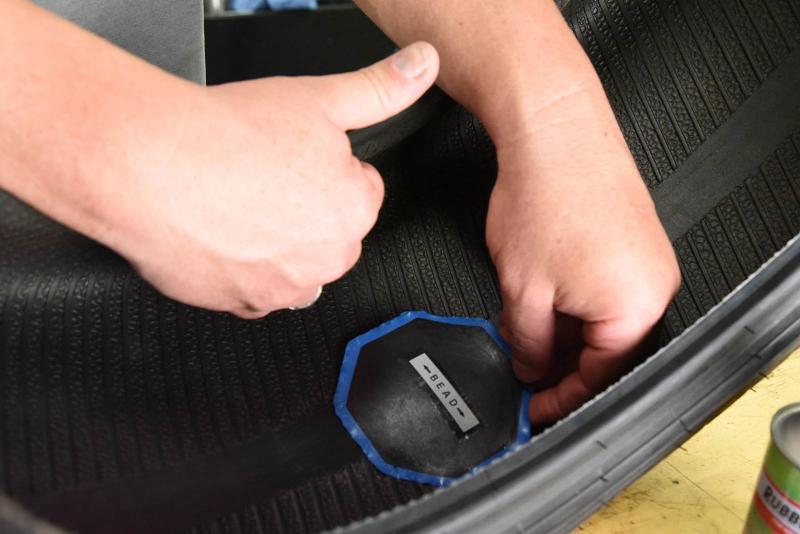 Please see our terms of service for more details
Please see our terms of service for more details
4.2 Average Rating
Service Hours
7 AM - 9 PM
7 days a week
Phone Number
1 (855) 347-2779
Phone Hours
Mon - Fri / 6 AM - 5 PM PST
Sat - Sun / 7 AM - 4 PM PST
Address
We come to you at no extra charge
Guarantee
12-month/12,000-mile warranty
Our certified mobile mechanics perform over 600 services, including diagnostics, brakes, oil changes, scheduled mileage maintenances, and will come to you with all necessary parts and tools.
Get a fair & transparent quote instantly before booking.
SEE REVIEWS NEAR ME
11 years of experience
585 reviews
Request Nicholas
Nicholas
11 years of experience
Request Nicholas
by Gloria
Toyota Camry V6-3.0L - Spare Tire Installation - Knightdale, North Carolina
Nicholas finished an earlier appointment which enabled him to come by earlier than originally scheduled. I'm very grateful he chose to reschedule. While replacing a flat with my donut spare, he instructed me on how to safely drive to the tire shop for the repair. More importantly to have the shop add air to the donut spare. Nicholas did an excellent job. He as very professional. Thank you
I'm very grateful he chose to reschedule. While replacing a flat with my donut spare, he instructed me on how to safely drive to the tire shop for the repair. More importantly to have the shop add air to the donut spare. Nicholas did an excellent job. He as very professional. Thank you
by Jairus
Ford E-150 Econoline - Spare Tire Installation - Durham, North Carolina
I was VERY pleased with Nicholas' expertise and was more than delighted that he was so prompt. He was very polite and friendly, and he did a marvelous job. If I ever need any repairs to my vehicle in the future, I would definitely ask for Nicholas.
29 years of experience
91 reviews
Request Luis
Luis
29 years of experience
Request Luis
by Saravana
Toyota Prius L4-1.5L Hybrid - Spare Tire Installation - Prospect Heights, Illinois
Luis attended my car today and help in fixing the issue quickly. He is nice and friendly guy. I will recommend him for any services.
11 years of experience
106 reviews
Request Hugh
Hugh
11 years of experience
Request Hugh
by Laura
Toyota FJ Cruiser V6-4.0L - Spare Tire Installation - Castle Rock, Colorado
Hugh came to change out a flat tire for my spare today. I have to say that I feel sheepish for calling someone to come help because I know how to change a tire but I was at work and on shift until 2 am and he came to my place of work. Instead of just installing my spare, he took the time to evaluate the situation. I had a nail in my tire and he took the tire to get patched and my vehicle drove better on my way home than when I left this morning. It was snowing sideways when he showed up to help me. He was a bit of a godsend in the moment and I would recommend him to anyone. I was just distressed because I did not have enough tip to give this guy for overachieving when I needed it. Huge five star review. I only hope to pay his generosity forward. He was more than worth the cost and he did a phenomenal job.
He was more than worth the cost and he did a phenomenal job.
26 years of experience
88 reviews
Request Jonathan
Jonathan
26 years of experience
Request Jonathan
by Adam
Honda Civic L4-1.7L - Spare Tire Installation - Smyrna, Georgia
Jonathan was very punctual, friendly, and transparent. He clearly explained everything he did and provided detail about any additional work he recommended. Great work!
Our certified mobile mechanics make house calls in over 2,000 U.S. cities. Fast, free online quotes for your car repair.
GET A QUOTE
GET A QUOTE
How Do I Check My Tire Pressure?
Checking Checking air pressure on your tires is part of basic car maintenance. Check your tires once a week and before any long trips. You may use a tire pressure gauge to measure accurately, or just look closely to see.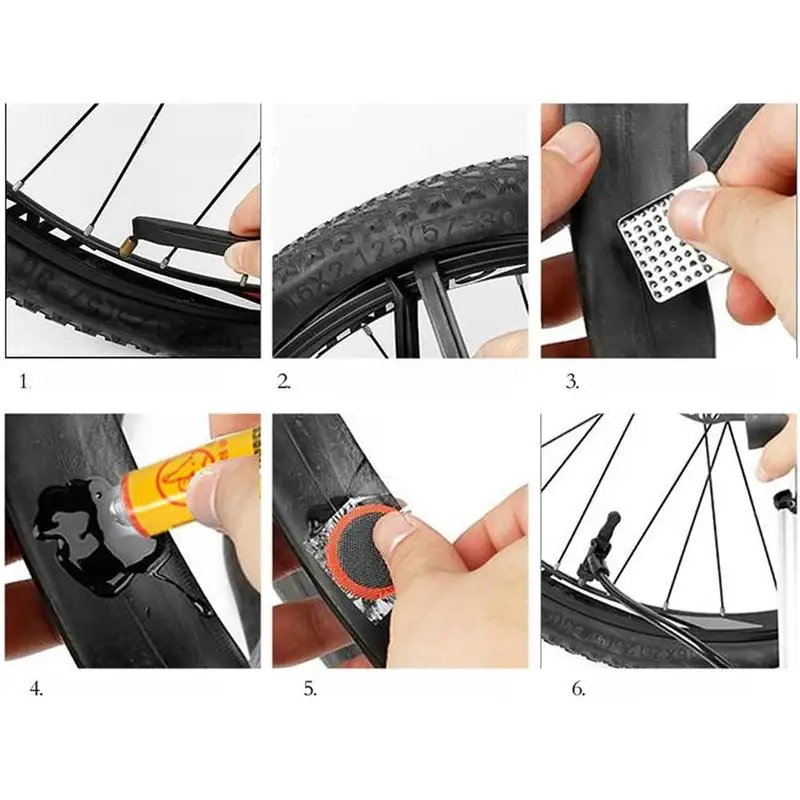 ..
..
How to Fix a Flat Tire
Knowing how to fix a flat tire on a car is part of being a safe driver. Driving on flat tires is dangerous so it's smart to repair flat tires quickly.
How to Handle a Burst Tire
Tires burst when the tire pressure is too low or too high, there is a mechanical defect in the tire itself, or a foreign object damages the tire.
Car wobbles in the rear.
You could have a bent rim or a bent hub. I would have the rim and hub checked to see which one is bent. I would recommend having a mechanic, like the certified ones at YourMechanic, come and check it...
All 4 tires on my car have premature tread wear
You will have work through Firestone. This is the link to the warranty info (https://www.tirerack.com/images/pdf/warranty/BFS0514.pdf) for the F740 tire and on page 23 is the contact information to their customer relations department.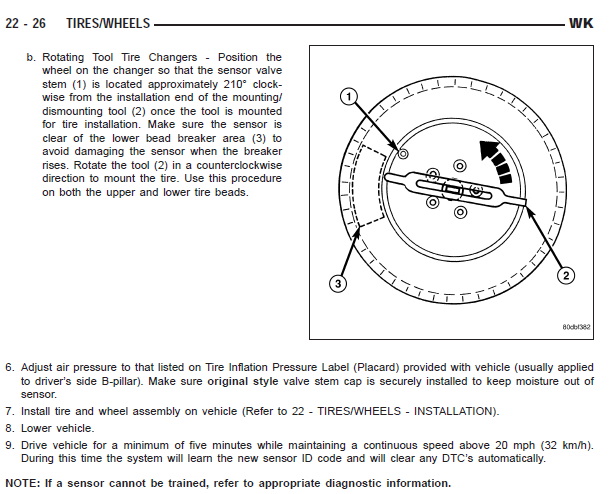
Car pulls to the right after replacing the driver side rear tire.
Logically, if the car started pulling immediately AFTER you put a new tire on the rear, it would seem unlikely that the pulling is due to an alignment issue. Uneven tire inflation will cause pulling so do check to make...
Cities
Maintenance
Estimates
Our service team is available 7 days a week, Monday - Friday from 6 AM to 5 PM PST, Saturday - Sunday 7 AM - 4 PM PST.
1 (855) 347-2779 · [email protected]
Read FAQ
GET A QUOTE
Every editorial product is independently selected, though we may be compensated or receive an affiliate commission if you buy something through our links. Ratings and prices are accurate and items are in stock as of time of publication.
Ratings and prices are accurate and items are in stock as of time of publication.
Modern vehicle tires are tough, standing up well to rough terrain and thousands of miles of driving. Trouble is, tires are not invincible. Every so often car tires spring leaks. Air can start leaking from anywhere on a tire, and the location of the leak determines whether or not you can fix it yourself. And if you can't fix it yourself, the location of the leak will also tell you if you need a professional repair or a new tire.
Whether or not your tire is tubed or tubeless affects things, too, because only tubeless tires can be repaired using the technique of plugging that we'll show you here. The good news is that modern vehicles always have tubeless tires, and this means that repairing with a rubber plug is often an option.
Plugging a tubeless tire is only a possibility when your puncture is in the tread area. If the air leak is where the sidewall of the tire meets the rim — this is called a "bead leak" — you'll need to visit a mechanic with a tire machine to dismount the tire from the rim and remount it with sealing liquid applied to the bead. If your sidewall has been punctured, you need a new tire, because damage there can lead to a blowout at highway speeds, even after repair.
If your sidewall has been punctured, you need a new tire, because damage there can lead to a blowout at highway speeds, even after repair.
Learn exactly how to plug a tire so next time you spring a leak between your treads, you'll be able to get up and running again in record time.
Total time completing the repair is about 15 minutes. Doing the work yourself will save you about $20 and the time spent driving to the garage and waiting.
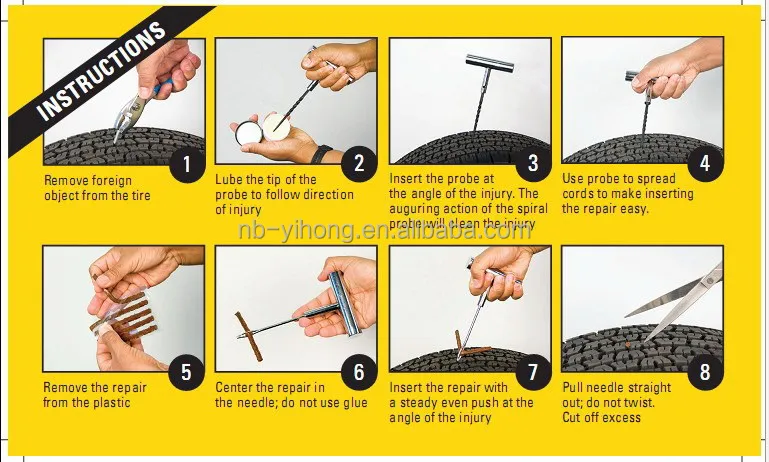
Steve Maxwell for Family Handyman
Complete DIY projects like a pro! Sign up for our newsletter!
Do It Right, Do It Yourself!
Originally Published: August 27, 2020
Vladimir Gavrilov
Estimated reading time: 3 minutes
7934
Category: Service Auto
In the spring, you often have to resort to the services of tire fitting services. The wheel suddenly descends, and one swap with the compressor is enough for literally a couple of hours. This is enough to get to the workshop. Employees usually inspect the tire and offer repair options of varying cost and complexity, ranging from a simple flagellum to a complex patch on the inside of the tire. Which way do you prefer? nine0005
The wheel suddenly descends, and one swap with the compressor is enough for literally a couple of hours. This is enough to get to the workshop. Employees usually inspect the tire and offer repair options of varying cost and complexity, ranging from a simple flagellum to a complex patch on the inside of the tire. Which way do you prefer? nine0005
Repair with a small tape impregnated with sealant is the simplest and cheapest of all the methods listed. Even a motorist on the side of the road can execute it. To repair with a flagellum, it is not necessary to remove the wheel from the hub.
Flange repair kits are available from all parts stores. They include an awl, a file, flagella and sealant. The repair technology is simple. First, a puncture site is searched for in the rubber, a nail or self-tapping screw is removed with pliers, and the resulting hole is cleaned with a file. nine0005
Usually, the tool is screwed into the hole like a self-tapping screw, and then pulled out along with the bits of rubber embedded in it.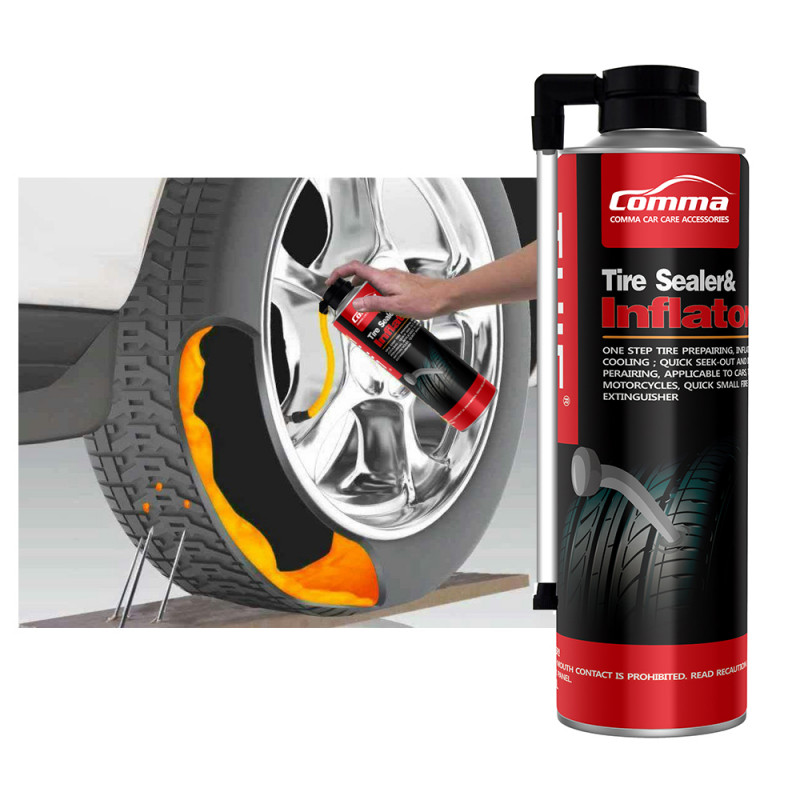 The hole is smooth and round.
The hole is smooth and round.
Next, you can put the flagellum. They are sold in packages and in a protective film that prevents the applied sealant from drying out. The length of each flagellum is about 200 mm.
Take an awl with an eye for installing the harness and push it into the hole in the tire to the middle. The ends of the bundle remain outside. We pull out the awl and cut off these ends. The flagellum completely closes the hole and can easily withstand pressure up to 3 atm. nine0005
True, such repairs are short-lived. Over time, the flagellum is squeezed out of the hole, and the wheel begins to bleed air. Therefore, if possible, it is better to visit a tire shop and install a more reliable element.
This tool is used for quality and reliable tire repairs. True, the installation of the fungus is possible only in the workshop after removing the tire from the disk.
The repair tool is an adhesive patch with a foot to fill the puncture site. After cleaning the damage with a file, the fungus is inserted into the hole from the inside and pressed tightly with a press for a better fit. The leg and cap, lubricated with glue, are well fixed on the rubber and cover the puncture site. Such a patch can work for many years without losing pressure in the wheel. But this repair is five times more expensive than installing a flagellum. They resort to it if the hole turned out to be large. nine0005
After cleaning the damage with a file, the fungus is inserted into the hole from the inside and pressed tightly with a press for a better fit. The leg and cap, lubricated with glue, are well fixed on the rubber and cover the puncture site. Such a patch can work for many years without losing pressure in the wheel. But this repair is five times more expensive than installing a flagellum. They resort to it if the hole turned out to be large. nine0005
This type of repair has been used for many decades. Twenty years ago, it was almost the only way to repair major damage. However, now patches are extremely rare.
Their disadvantage is that, due to the large fixation area, it is rarely possible to adhere the material evenly. Cavities appear through which air escapes.
However, a patch may be necessary for severe cord cuts with torn rubber damage that the fungus can no longer cope with. It is difficult to clean them, which is why the leg of the fungus cannot fit snugly into the puncture site. Therefore, the entire problem area is sealed with a layer of rubber. nine0005
Therefore, the entire problem area is sealed with a layer of rubber. nine0005
Patches are not as reliable as fungus, but they do help to repair half-centimeter cuts. Sometimes patches are even glued to hernias from the inside in order to keep the tire working for some more time for a trip to the wheel shop.
Long driving with patches is not recommended.
tire repaircar maintenancetips for motorists
Next article
Media news2
Author: Aleksey Kokorin
Experienced drivers are not surprised by such a trifle as a puncture, but for the first time beginners usually get confused in the sequence of actions, forget about important details and do not know what to do with a punctured wheel even in a tire shop - especially if they start offering choose from several options or intimidate with expensive repairs. Let's set up an operation algorithm when a flat tire is detected and figure out what to do right away and what to choose later. nine0070
Let's set up an operation algorithm when a flat tire is detected and figure out what to do right away and what to choose later. nine0070
What to do when you find a puncture
Having found a flat tire, first of all you need to stop in a safe place, turn on the alarm, assess visibility and, if necessary, set an emergency stop sign: according to traffic rules, it is installed at least 15 meters from the car in the village and at least 30 meters outside the settlement. When choosing where to stop, consider the space to the side of the vehicle to handle a flat tire. You should not stop right on the road and in places where stopping and parking are prohibited: even if a punctured wheel belongs to the conditions of a forced stop, it is quite possible to drive several tens of meters on it to choose a safe and convenient parking place. At night or in conditions of limited visibility (for example, in fog or rain), it is imperative to wear a vest with retroreflective elements - this is required by clause 2. 3.4 of the SDA and common sense. nine0070
3.4 of the SDA and common sense. nine0070
Now you can start working on the wheel. We will sequentially consider several options for action, and then move on to ways to repair a damaged tire.
The most obvious solution to a flat tire is to replace it. If you have a spare tire that you are sure is in good condition, the best option is to install it and visit a tire shop to repair a punctured tire - such repairs will be more reliable and of high quality than doing it yourself.
If you do not have a suitable spare tire, but you do have a pump or compressor, you can assess the damage to the tire and try to inflate it again to get to the tire shop. It is better to start searching for an air leak with a valve (aka “nipple” or “nipple”): often a faulty spool becomes the cause of a flat tire. It is easy to check it: unscrew the protective cap (if there is one), pour water on it (or slobber it, as in childhood): air bubbles will leak. In this case, you can try to replace the spool valve by unscrewing it and screwing in a new one, but if there is no new valve, as well as a store nearby, you can try just unscrewing and screwing it back in. Regardless of whether it helped or not, you need to visit a tire shop to replace the entire spool or valve. nine0070
Regardless of whether it helped or not, you need to visit a tire shop to replace the entire spool or valve. nine0070
If the valve is tight and the tire is flat, it is most likely a puncture. The easiest way to find a puncture that is free of foreign objects is to pour water on the tire while looking at the surface: the damage will reveal itself as air bubbles. However, often the cause of the puncture can be found along with it: a self-tapping screw, nail or other arbitrary object sticking out of the wheel will clearly indicate the place of depressurization. In this case, you do not need to immediately remove the foreign object from the tire: it partially seals the hole, and if the pressure loss is slow, you can try to pump up the wheel and drive to the tire shop. nine0070
The same goes for wheels that are leaking from the rim or from a faulty valve. Usually, in this case, the air is bled slowly, and you can pump up the wheel and have time to get to the place of repair. By the way, rim leakage can occur due to disk deformation upon impact - for example, when hitting a pit with sharp edges. Such situations are fraught with damage to both the disk and the sidewall of the tire, in which case the disk will need to be corrected, and the tire repaired or even replaced. To avoid rim leaks, you need to inspect the rims every time you change tires. The loss of tightness occurs either due to corrosion or due to disc deformation, and not only steel, but also light alloy wheels can corrode. So if you see paint blistering or rust on the rim, the tires need to be put on rim sealant: when changing tires, this will be cheaper than the subsequent removal and re-tire to fix a leak on the rim. nine0070
By the way, rim leakage can occur due to disk deformation upon impact - for example, when hitting a pit with sharp edges. Such situations are fraught with damage to both the disk and the sidewall of the tire, in which case the disk will need to be corrected, and the tire repaired or even replaced. To avoid rim leaks, you need to inspect the rims every time you change tires. The loss of tightness occurs either due to corrosion or due to disc deformation, and not only steel, but also light alloy wheels can corrode. So if you see paint blistering or rust on the rim, the tires need to be put on rim sealant: when changing tires, this will be cheaper than the subsequent removal and re-tire to fix a leak on the rim. nine0070
If you find a puncture, but there are no foreign objects in it, and you do not have a spare wheel and tire repair kits, there is another folk method of temporary "repair". You can screw a self-tapping screw into the found hole - if, of course, you have one. In extreme cases, a self-tapping screw can be searched in the cabin by unscrewing it from some interior detail. This method cannot be called reliable: it is unlikely to completely seal the wheel, but at least it can help you get to the nearest tire shop. nine0070
This method cannot be called reliable: it is unlikely to completely seal the wheel, but at least it can help you get to the nearest tire shop. nine0070
And a couple more useful remarks. If the wheel is completely flat, then it is easier to inflate it without a spool: the latter must be unscrewed, then the tire must be inflated and quickly screwed back in. The fact is that the spool itself, when inflated, resists the compressor, and in the event of a loose fit of a flat tire to the disk, the power of a simple magazine compressor may not be enough, and the absence of a spool helps to increase air flow and facilitate the operation of the compressor. If this does not help, you can jack up the car by hanging a flat tire: this will improve the fit of the tire to the disk, and the chances of inflating the tire will increase. nine0070
On-Site Repair Methods
Now let's look at options for repairing a tire yourself using special materials that you should take with you or, if a puncture caught you in the city, buy at the nearest car shop.
1. The most common, cheapest and easiest way to repair yourself is to install a raw rubber band. The harnesses are sold complete with an abrasive awl to expand the hole in the tire and improve the contact of the repair harness with its edges, as well as a needle for installing the harness and an adhesive to fix it and at the same time seal the puncture. When choosing a repair kit in a store, you should pay attention to the following nuances:
Install the harness in the following order. First, the found hole is expanded with an abrasive awl - you need to insert and remove it several times into the puncture site. Then the tourniquet is inserted into the eye of the needle, and glue is applied to it. After that, the needle with the tourniquet must be inserted into the hole in the tire and pulled out sharply - so that the tourniquet remains in the hole, and the needle comes out without it. If everything worked out, it remains only to cut the end of the harness flush with the surface of the tire and pump up the wheel. nine0070
After that, the needle with the tourniquet must be inserted into the hole in the tire and pulled out sharply - so that the tourniquet remains in the hole, and the needle comes out without it. If everything worked out, it remains only to cut the end of the harness flush with the surface of the tire and pump up the wheel. nine0070
The advantages of repairing with a harness are quite decent reliability, simplicity and low cost. On a well-repaired tire, you can drive for a long time, and if the repair site starts to poison, you can either replace the harness or have the tire repaired in a quality service. Among the minuses is the possibility of damaging the cord during installation, as well as lower reliability compared to “full-fledged” repair methods in a tire shop. Strictly speaking, the tourniquet is still a temporary repair, so if it is possible to pump up the wheel and get to the tire fitting, then it is better not to enlarge the hole in the tire and get to the experts. nine0070
2. The second repair option is aerosol liquid sealants sold in cans. To repair a punctured tire with sealant, you need to remove the foreign object from the puncture site, then pour the sealant into the wheel through the valve, twist it to distribute the composition inside the tire, pump up the wheel and drive several kilometers at low speed for the final uniform distribution of the sealant.
The second repair option is aerosol liquid sealants sold in cans. To repair a punctured tire with sealant, you need to remove the foreign object from the puncture site, then pour the sealant into the wheel through the valve, twist it to distribute the composition inside the tire, pump up the wheel and drive several kilometers at low speed for the final uniform distribution of the sealant.
The advantage of this repair is that it is easier and less labor intensive than installing a harness. However, there are also disadvantages: the larger the hole, the higher the chance that the sealant will not be able to eliminate it, and such a repair can affect the wheel balance. Compared to a tourniquet, it can be considered even less reliable and preferable, but simpler. nine0070
Repair options at a tire shop
If you put in a spare tire and brought the wheel to a tire shop, you may also be offered several repair options. Consider the most popular with an indication of the advantages and disadvantages.
1. The first repair method is the same harness installation as described above. As we remember, the tourniquet refers to a temporary repair, so among tire specialists this method is considered bad form, but many workshops do not exclude it from the list of services. All the advantages and disadvantages are the same here: such a repair will be the fastest, simplest and cheapest, but less reliable than other methods. It is worth choosing it in cases where the price and / or speed of the procedure is more important to you than anything else. If quality is a priority, then it is better to fork out for the options listed below. nine0070
2. The second option for repairing a puncture is to install a patch on the inside of the tire, the so-called cold vulcanization. In this case, the tire is removed from the disk, the surface around the puncture is treated with an abrasive, and the damage is sealed with a special patch. This is a more preferred repair method than a tourniquet: it is more reliable and durable, especially in the case of side punctures, when not the thick tread part of the tire is damaged, but the thinner sidewall.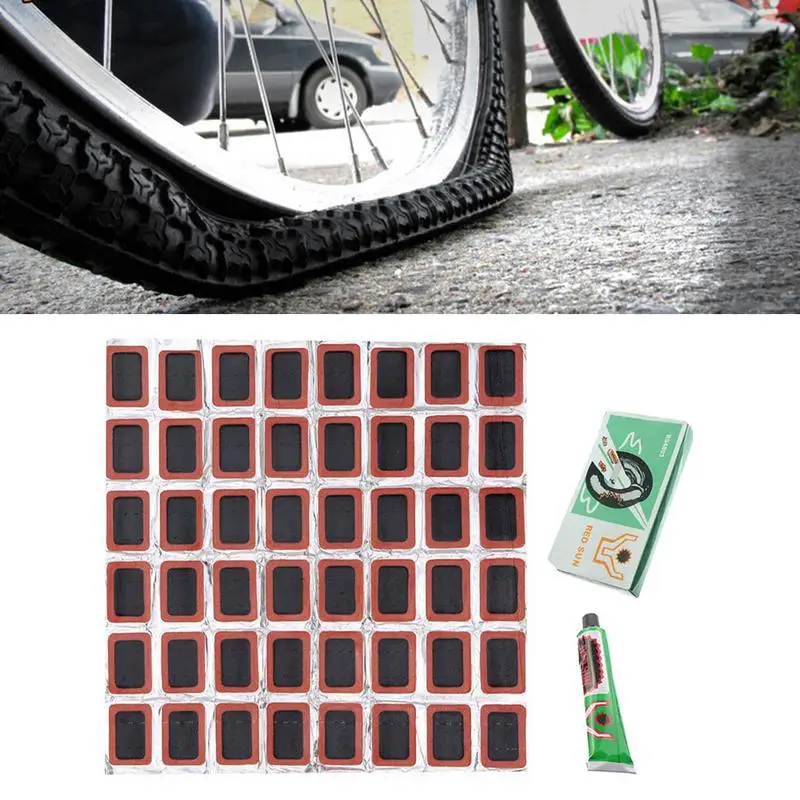 Among the minuses, only a higher cost can be noted: in addition to the actual tire repair, you will have to pay for the removal and installation of the wheel (or do it yourself), tire fitting and balancing. nine0070
Among the minuses, only a higher cost can be noted: in addition to the actual tire repair, you will have to pay for the removal and installation of the wheel (or do it yourself), tire fitting and balancing. nine0070
3. The third option is a "complex" of the first and second: installation of the so-called repair "fungus". The “hat” of the fungus is a patch, and the “leg” is threaded from the inside of the tire to the outside. After gluing the patch, the excess part of the leg is cut off, as in the case of the tourniquet. Thus, not only the inner surface of the tire is closed, but also the hole itself. The advantages and disadvantages of this repair method are generally the same as those of a patch.
4. An extreme, “emergency” measure when repairing a punctured wheel is to install a camera in it. Typically, this method is used for tires that are no longer worth repairing, or “for reliability” after repairing a complex puncture. It should be understood that almost all modern tires are tubeless, that is, they are not designed to install a camera, so it’s not worth driving a wheel repaired in this way for a long time.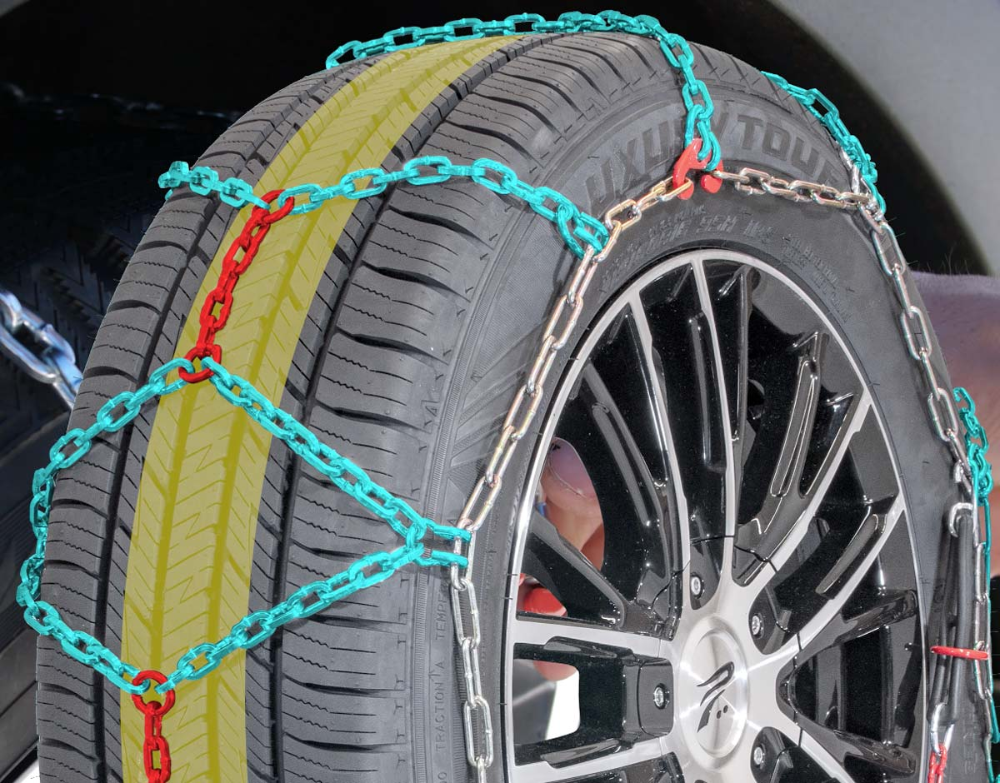 Installing a tube is a temporary solution for riding until a new tire is purchased, and sometimes such wheels are left as spares. So this repair method can be kept in mind as a backup. nine0005
Installing a tube is a temporary solution for riding until a new tire is purchased, and sometimes such wheels are left as spares. So this repair method can be kept in mind as a backup. nine0005
Finally
We deliberately left out of this text such methods as combined repair of tires with a tourniquet and a patch and hot vulcanization. The first is used quite rarely and for specific damage, and it is enough just to know about its existence. Well, the second is used to repair serious side cuts, and it is not only rare, but also very expensive. The cut site in this case is prepared, filled with raw rubber and processed with a hot press for vulcanization. Equipment for this procedure is not available in every tire shop, and the cost of repair can be about half the cost of a new tire. nine0070
interesting popular questions
Articles / Interesting Faster than they look: 15 best sleepers of 2023 We talked in detail about what sleepers are - these are outwardly inconspicuous cars that can actually give odds to many in traffic light races. And the recently introduced fifth po... 1573 0 1 01/03/2023 nine0005
And the recently introduced fifth po... 1573 0 1 01/03/2023 nine0005
Articles / Practice Eternal youth: how to prevent the car body from aging Those who have bought a new car at least once in their lives experienced a feeling that can be described by the common phrase "if only nothing happened to the swallow." But life is so badly arranged that with la ... 3249 1 four 27.12.2022 nine0005
Articles / Popular questions Area of action of road signs: how to determine it Road signs are well known to almost all drivers. But many, years after driving school, sometimes ask themselves the question: “how long does the sign that I just passed?”. To the head... 2049 0 1 27.12.2022 nine0005
But many, years after driving school, sometimes ask themselves the question: “how long does the sign that I just passed?”. To the head... 2049 0 1 27.12.2022 nine0005
Test drives / Test drive Haval Dargo vs Mitsubishi Outlander: the dog is barking, the stranger is coming In the Haval dealership in the south of Moscow, life is in full swing: buyers look at cars, communicate with managers and sign some papers. While I was waiting for the test Dargo, the same cross... 21015 7 205 13.09.2022
Test drives / Test drive Motor from Mercedes, emblem from Renault, assembly from Dacia: test drive of the European Logan 1.